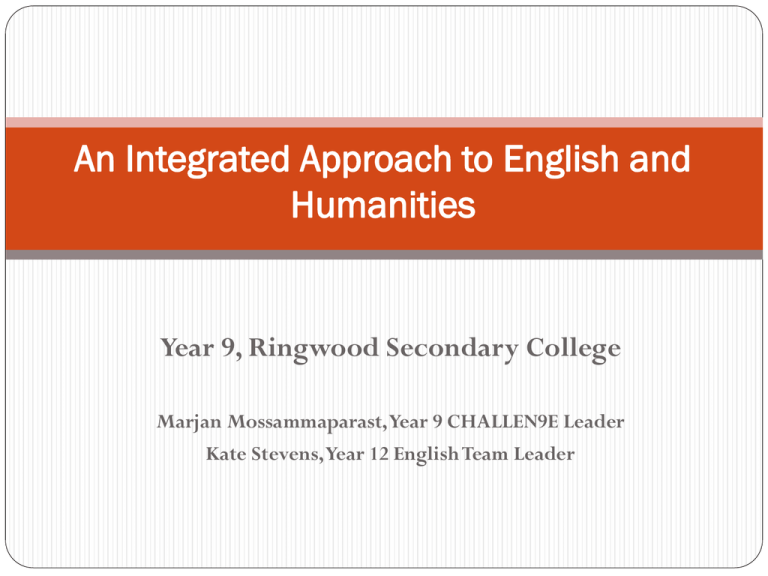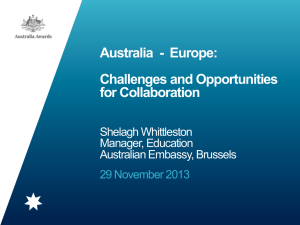An Integrated Approach to English and Humanities
advertisement

An Integrated Approach to English and Humanities Year 9, Ringwood Secondary College Marjan Mossammaparast, Year 9 CHALLEN9E Leader Kate Stevens, Year 12 English Team Leader What is it? • A new integrated English/Humanities subject at year 9 (combines domains of English, History and Geography) • Allocated 9 x 73 minute periods per fortnight • This time allocation means that we have between 4 and 5 sessions with our class per week • Benefits and drawbacks? Key Elements: Instead of being traditionally focused on skills as the starting point for studies, the subject teaches these core skills through the lens of an essential question each semester: o Semester 1: What does it mean to be an Australian? o Semester 2: What are the forces at work in our world? Develops key English skills of reading, writing and speaking and listening Students learn physical and human geography and the interaction between these two systems, as well as geospatial skills Students undertake a broad study of the history of Australia and focus on particular time periods, including: o the history of migration and how it has shaped (and continues to shape) the nation o pre-contact Australia and the effect (continuing) of the encounter between British and Aborigines o the Gold Rush and the Chinese in Australia o the development of the Melbourne Staffing 10 teachers (including ESL stream), including: o 4 VCE English teachers (including Head of English) o 2 core Geography teachers o 2 core History teachers Work in strong team – meet at the start of each term to map out the details of classes and divide responsibilities for common assessment tasks Team leader (CHALLEN9E Leader) attends English, History and Geography faculty meetings to report, discuss and disseminate, and represents the program on Curriculum Committee PD for staff working outside their key areas of strength eg. History/Geography PD offered to staff to highlight key skills needed in VCE History and Geography (to ensure continuity of learning) Context + Rationale: Year 9 CHALLEN9E Program • The new integrated English/Humanities subject was a response to the restructuring of year 9 in light of the new CHALLEN9E Program, implemented in 2010 • Purpose of CHALLEN9E: to meet the needs of young people in an increasingly complex world by fostering: o o o o o o choice and student agency empowerment and responsibility academic rigour and accountability character development connected to school and community transformation and transition CHALLEN9E Program: Structure Students in CHALLEN9E work in one of 9 tutor groups, each guided by an interGREAT tutor They work through an integrated program of core studies incorporating the subjects of: o English/Humanities o Maths and Science (both taught by the same teacher) o interGREAT (whole day Wednesday) o Physical Education • There is also a comprehensive elective program covering subject areas such as creative and performing arts, design and technology, LOTE and Duke of Edinburgh • Students experience most classes with key teachers, one of whom doubles as the interGREAT tutor, enhancing the Pastoral Care program • Year level is structured into 3 communities and student welfare and management is provided by one of 3 Community Heads interGREAT • A key feature of CHALLEN9E is the weekly interGREAT program • Each Wednesday, students are guided by their interGREAT tutor through a structured program with many varied focuses, including: o o o o o o o o o • Each term, all learning activities are based around the overarching themes of: o o o o • • Guest speaker presentations eg. Boori Pryor Values education and pastoral care eg. ethics Curriculum based excursions eg. Chinatown Excursion, Hampton Beach Excursion Student leadership eg. CHALLEN9E Student Council; Tutor Group Assembly Presentations Goal setting and guided reflection on learning progress, inc. regular completion of Learning Portfolio Personal and Community Projects (focus on civics and citizenship in action) Literacy, Numeracy and ICT skills toolbox sessions eg. NAPLAN preparation Interest based workshop Weekly Extension Series and support sessions (run through Eng, His, Geo, Maths and Science faculties) The Self The Self in the Community The Self in theWorld Future Self interGREAT provides the flexibility for faculties to add extra time to their core courses eg. Maths Common Test, NAPLAN revision, Reconciliation Week/Refugee Week activities etc. The interGREAT year begins with a three day camp for all students Sample Community Project C+C: Course Outline Semester 1 – What does it mean to be an Australian? Term 1: This term students will undertake a study of coastal systems and the impact of human interaction with these systems. They will consider how Australia’s natural environment has shaped the identity and activities of Australians in the past, including its indigenous populations, and how it influenced the establishment and development of British settlement. They will explore how Australia’s natural environment, especially the coastal nature of the continent, continues to shape the population distribution and culture of modern Day Australia. Tasks this term will focus on: consolidating mapping skills; developing historical analysis skills through the completion of document studies; developing oral skills through a persuasive oral presentation; developing personal, narrative and imaginative writing skills and using the language of descriptions. Students will also take part in a coastal fieldtrip to Hampton Beach and complete a geographic fieldtrip report. C+C: Course Outline Term 2: This term students will undertake a study of the history of migration (commencing with a broader look at the process of colonization) and its impact in shaping Australian society. They will focus particularly on the impact of migration on indigenous cultures and explore issues arising from this encounter. They will also analyze the impact of the arrival of Chinese migrants during the Gold Rush period and trace the roots of Australia’s multicultural composition, as well as its consequences on the development of migration policies, including the White Australia policy. Tasks this term will focus on: developing historical essay writing through the study of the film text “Ten Canoes”; analyzing the use of language to persuade and position an audience; examining primary and secondary sources and completing document studies and historical research. Students will also take part in a fieldtrip to Chinatown and complete a fieldtrip report. C+C: Course Outline Semester 2 – What are the forces at work in our world? Term 3: This term students will study the physical forces and the non-physical forces that operate in both the inner and outer world and exert an influence over human beings. Students will undertake a textual study of the novel “The Killer’s Tears” set in Chile, and will use this text as a springboard for the geographic study of the forces of nature through a tectonics unit. More broadly, students will examine the force of urbanization that pulls populations to the cities, and will consider both the benefits and the challenges that ensue by using the city of Melbourne as a case study and focusing on the history of its development. This provides a strong foundation for the City CHALLEN9E experience (the formal project of which is assessed through the subject of interGREAT), which constitutes a week spent in the city towards the end of term. Tasks this term will focus on utilizing the geographic SHEEPT analysis tool to formulate an understanding of the history of the development of Melbourne city, a writing folio based on the text “The Killer’s Tears” that explores the nature of the forces at work in our worlds, a dramatic persuasive oral presentation that engages with contentious issues such as urban sprawl/capital punishment (link to both “The Killer’s Tears” and Ned Kelly), and a comparaitive Urban Field Walk. C+C: Course Outline Term 4: This term students will study the text “Of Mice and Men” and use this as a springboard to consider the forces that motivate us, including the power of dreams, the importance of goals and the significance of work in imparting a sense of identity, purpose and fulfillment in life. Historically, they will examine the life of the early settlers in Australia, especially women, through a study of a collection Australian short stories, including Henry Lawson’s “The Drover’s Wife”. Tasks this term will focus on analysis of the use of language to persuade and developing text response writing skills. Assessment at Work Within both semesters we provide various tasks that are largely English skills based with a choice of a close focus on Historical or Geographical components Within these tasks there are options for students to address either Historical or Geographical VELS components and be assessed on their ability to write/speak/write about reading and on their geographical or historical knowledge and understanding We also provide ‘straight’ tasks, that assess Historical/Geographical/English standards specifically and separately, and are common tasks given to all students Having such tasks ensures that each of the VELS strands are taught and assessed SEMESTER ONE: What does it mean to be an Australian? Common Assessment Tasks: 15% Task 1: Craft of Writing – Persuasive Essay (on historical issue) 15% Task 2: Oral Presentations – Factors influencing identity (inc. geographical factors) 30% Task 3: Reading and Responding – Ten Canoes Text Response; History Document Study 20% Task 4: Research – Migration Timeline 10% Task 5: Fieldwork – Coastal Fieldwork 10% Task 6: Tests/class work – Coastal Geography; relevant class work SEMESTER TWO: What are the forces at work in our world? Common Assessment Tasks 15% Task 1: Craft of Writing – ForcesWriting Folio 10% Task 2: Oral Presentations – The Killer’s Tears Dramatic/Persuasive 30% Task 3: Reading and Responding – Of Mice and Men Text Response; Language Analysis 15% Task 4: Research – SHEEPT Analysis of Melbourne City (focusing on history of city) 10% Task 5: Fieldwork – Comparative Urban Field Work; Historical Chinatown Fieldwork 10% Task 6:Tests/class work – Urbanisation Test, Violent Earth Test; relevant class work How can History help us to understand what makes an Australian? Sample from Term 1: What is my History? How has my History shaped who I am today? What is the History of the space I inhabit? What are the conflicts and events that have shaped the people around me? Is there only one History? How can I understand and trust History? Future Directions: The Australian Curriculum Points to remember: Can be incorporated into integrated programs Does not constitute whole curriculum of the school – room left for local interests and pursuits General Capabilities (addressed primarily through interGREAT): o Critical and creative (and caring) thinking o Self management, teamwork and social competence o Intercultural understanding o Ethical behaviours o Literacy o Numeracy o ICT The Australian Curriculum + Eng/Humanities • Years 7-10 of the Australian Curriculum focus on Australian History within a regional and world context • Year 9 – The Making of the Modern World (1750-1918) o o o o • Period of industrialisation Rapid change in way people lived, worked and thought Era of nationalism and imperialism Colonisation of Australia as part of expansion of European power (culminating in World War I) Key inquiry questions: o What were the changing features of the movements of people from 1750 to 1918? o How did new ideas and technological developments contribute to change in this period? o What was the origin, development, significance and long-term impact of imperialism in this period? o What was the significance of World War I? Overview – Year 9: • Identifies important features of the period (1750-1918) • Enables studies to understand broad patterns of historical change • Provides broader context for teaching of depth study • Constitutes 10% of total teaching time • Content for Year 9: o nature and significance of Industrial Revolution and how it affected living and working conditions (including in Australia) o nature and extent of movement of peoples in the period (eg. slaves, convicts, settlers) o extent of European imperial expansion and different responses o emergence and nature of significant economic, social, and political ideas of the period, including nationalism Depth Studies – Year 9: Making a Better World (3 electives) 1. Progressive Ideas and Movements Industrial Revolution Movement of Peoples o o o Influence of Industrial Revolution eg. unbanisation and increase in crime in English, leading to transportation of convicts and establishment of penal colony of Australia Experiences of people who moved and changes in way of life eg. convicts, free settlers, women Impact of movement of people eg. contact with indigenous population Australia and Asia (2 electives) 2. Asia and the World Making a Nation o o Extension of settlement and effects of contact eg. contact with indigenous populations Experience of non-Australians in Australia prior to 1900s eg. Chinese diggers Key events and ideas in development of Australian self-government and democracy eg. Federation Legislation eg. Immigration Restriction Act World War I 3. World War I o Causes and reasons for enlisting Places where Australians fought, inc. Gallipoli (interGREAT) Impact of WWI eg. changing role of women Commemoration of WWI, inc. debates around the nature and significance of ANZAC legend (also through interGREAT City CHALLEN9E) Historical Skills – Year 9: Chronology, terms and concepts o Timelines o Contestability of terms Historical questions and research o Developing questions o Locating sources Analysis and use of sources o Explaining contextual significance o Synthesising information from various sources o Understanding reliability and usefulness Perspectives and interpretations o Provisional nature etc. Explanation and communication o Developing historical argument o Using ICT Critical Learnings and Reflections Need for overarching narrative – both in curriculum design and in teaching Need for focus and tolerance of fragmentation Need for both consistency and flexibility between classes Importance of providing literacy support so that students who struggle with English can still succeed in this subject Remembering that this is a NEW subject – not trying to cram 3 syllabi into shortened time frame Importance of sharing and collaboration – working with strengths of the team Need for PD – both in-house and through external sources Getting rubrics rights Balancing depth as well as breadth Continual reassessment of how the subject fits into the overall structure and direction of the school ie. importance of embedding subject into systems of the school Evaluating student feedback – continuity of learning? Effectiveness? Questions? Thank you for your time. Marjan: mmossammaparast@ringwoodsc.vic.edu.au Kate: kstevens@ringwoodsc.vic.edu.au








